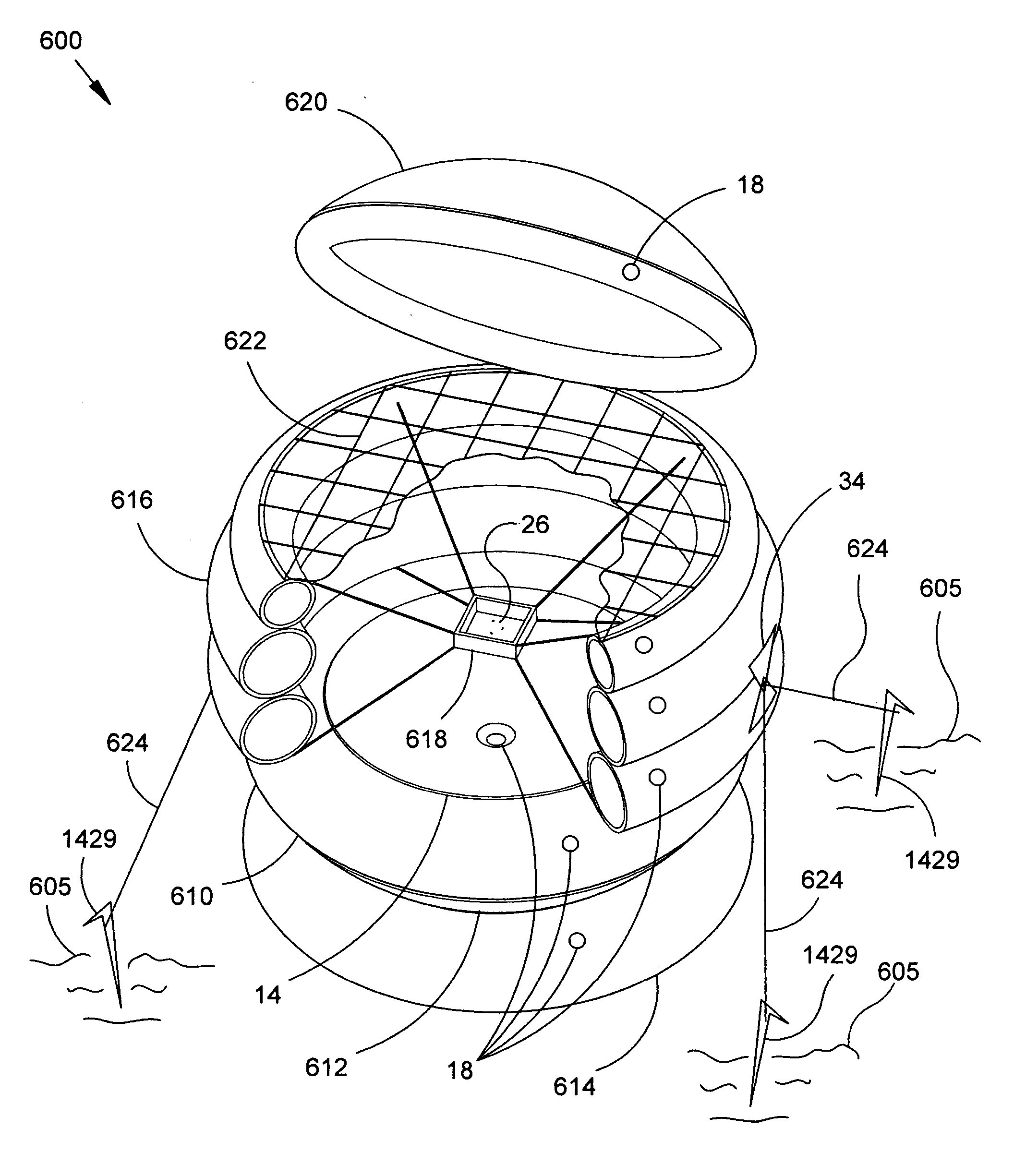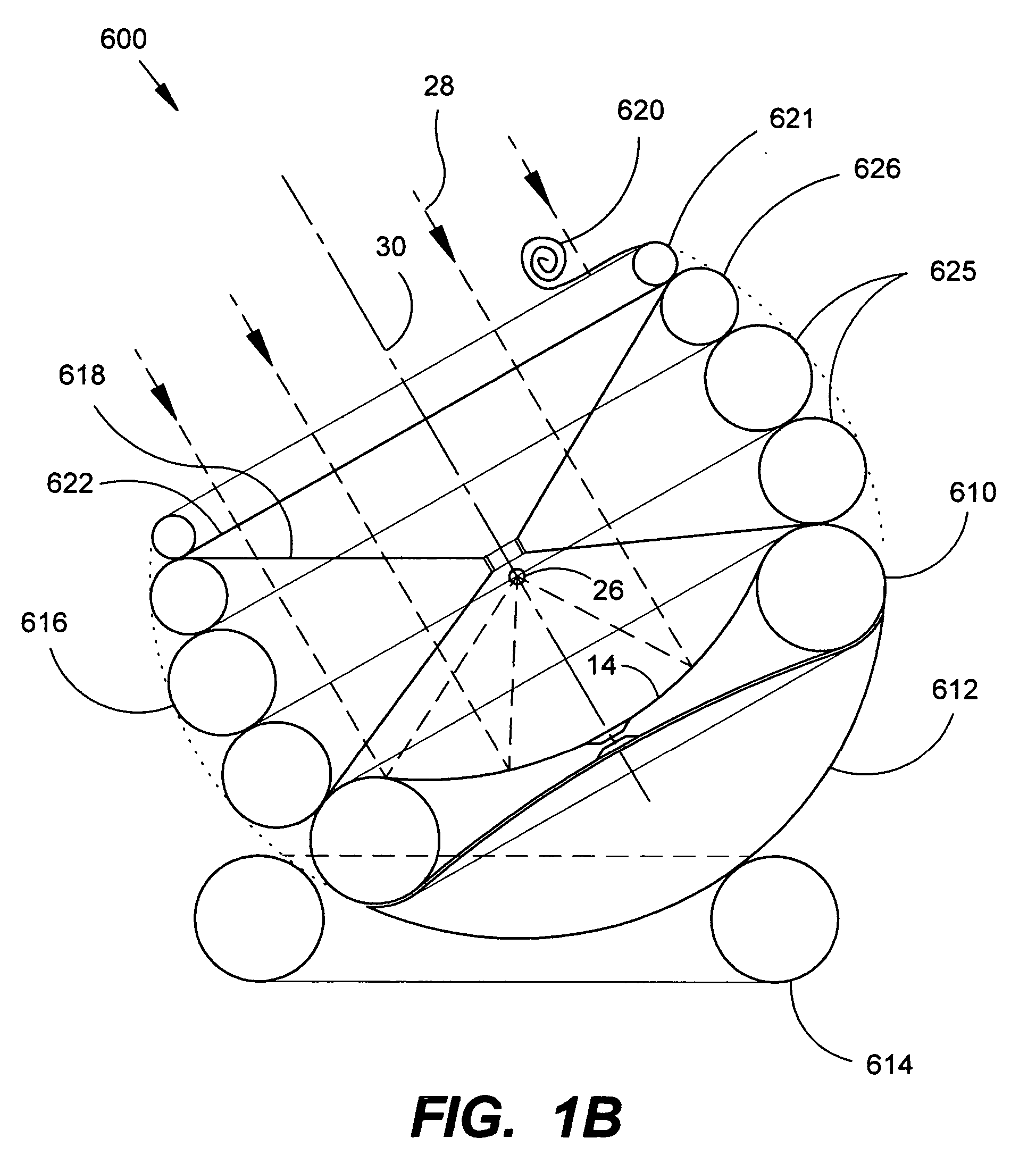Multi-function field-deployable resource harnessing apparatus and methods of manufacture
a multi-functional, resource-harnessing technology, applied in reverse osmosis, lighting and heating apparatus, instruments, etc., can solve the problems of plurality of losses, plurality of losses, and significant more limited utility and application limitations
- Summary
- Abstract
- Description
- Claims
- Application Information
AI Technical Summary
Problems solved by technology
Method used
Image
Examples
first embodiment
[0194]FIG. 1A depicts a typical selectably deployable, modular, inflatable, multifunction, field-deployable apparatus 600 comprising as its primary functional element a basic inflatable multifunction reflector apparatus 610 in a preferred first embodiment configuration. The apparatus 610 is shown optionally supported on its lower side by a removably (i.e., separably) attached inflatable spherical support 612, which is movably couched within an optional separate inflatable toroidal ring 614. The apparatus 610 is shown supporting on its upper side an optional removably attached inflatable safety shield 616 (shown partially cut away) or safety cage (or other safety member) that further supports an optional removably attached cable-stayed support 618 for holding various items, materials, and / or accessory elements (not shown) in proximity to the focal point 26 of the basic reflector apparatus 610.
[0195] In addition to the safety shield 616, two other safety devices or means are shown for...
second embodiment
FIGS. 4A-I: Description and Operation of the Basic Inflatable Reflector Apparatus—Second Embodiment
[0224] In FIGS. 4A and 4B, the second main embodiment device 386 is illustrated as an inflated toroid or ring support element 400 supporting an upper transparent membrane 388 and a lower reflective membrane 390. The transparent membrane 388 and reflective membrane 390 provide a central reflector chamber (i.e., pressure envelope) 392 with a double parabolic convex-convex lens configuration when inflated to a super-ambient pressure. The transparent membrane 388 has a centered inflation valve 18 for inflating the reflector chamber 392; however, it is noted that the inflation valve 18 may alternatively be located at any other useful location such as in the reflective membrane 390. The inflatable toroidal support element 400 also has a valve 18 for inflation to form a rigid ring. Two valves are shown for separate inflation of the ring support 400 and the reflector chamber 392; however, it i...
third embodiment
FIGS. 4K-O: Description and Operation of a Simplified Inflatable Reflector Apparatus—Third Embodiment
[0232] FIGS. 4K-O illustrate the construction and use of simplified alternate inflatable reflector apparatuses (third main embodiment) having only one membrane shown attached to an inflatable (or, optionally, otherwise collapsible or rigid) support element.
[0233]FIG. 4K depicts an alternate simple planar reflector or mirror apparatus 1510 provided by attaching as few as one planar (i.e., non-preformed) reflective membrane 1512 to the support ring 400. Although such an apparatus having only a single membrane is generally not operable as a single apparatus to concentrate electromagnetic energy, the apparatus 1510 can effectively serve as a highly portable self-imaging mirror, a photographic light reflector and / or diffuser, and / or a radiant electromagnetic energy heat shield (such as to shield a person object, or other item from radiant energy emitted from a fireplace, campfire, of oth...
PUM
 Login to View More
Login to View More Abstract
Description
Claims
Application Information
 Login to View More
Login to View More - R&D
- Intellectual Property
- Life Sciences
- Materials
- Tech Scout
- Unparalleled Data Quality
- Higher Quality Content
- 60% Fewer Hallucinations
Browse by: Latest US Patents, China's latest patents, Technical Efficacy Thesaurus, Application Domain, Technology Topic, Popular Technical Reports.
© 2025 PatSnap. All rights reserved.Legal|Privacy policy|Modern Slavery Act Transparency Statement|Sitemap|About US| Contact US: help@patsnap.com



